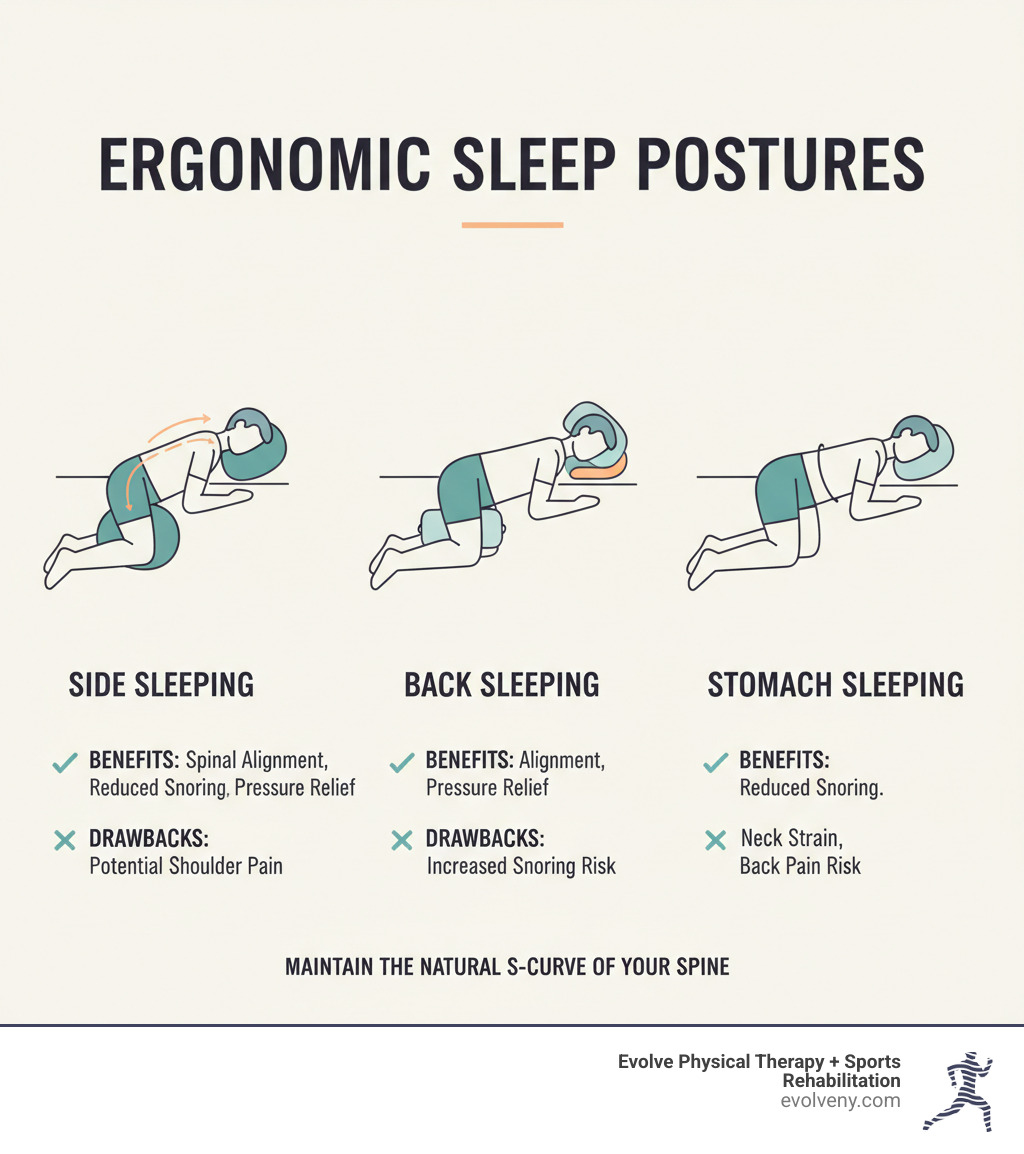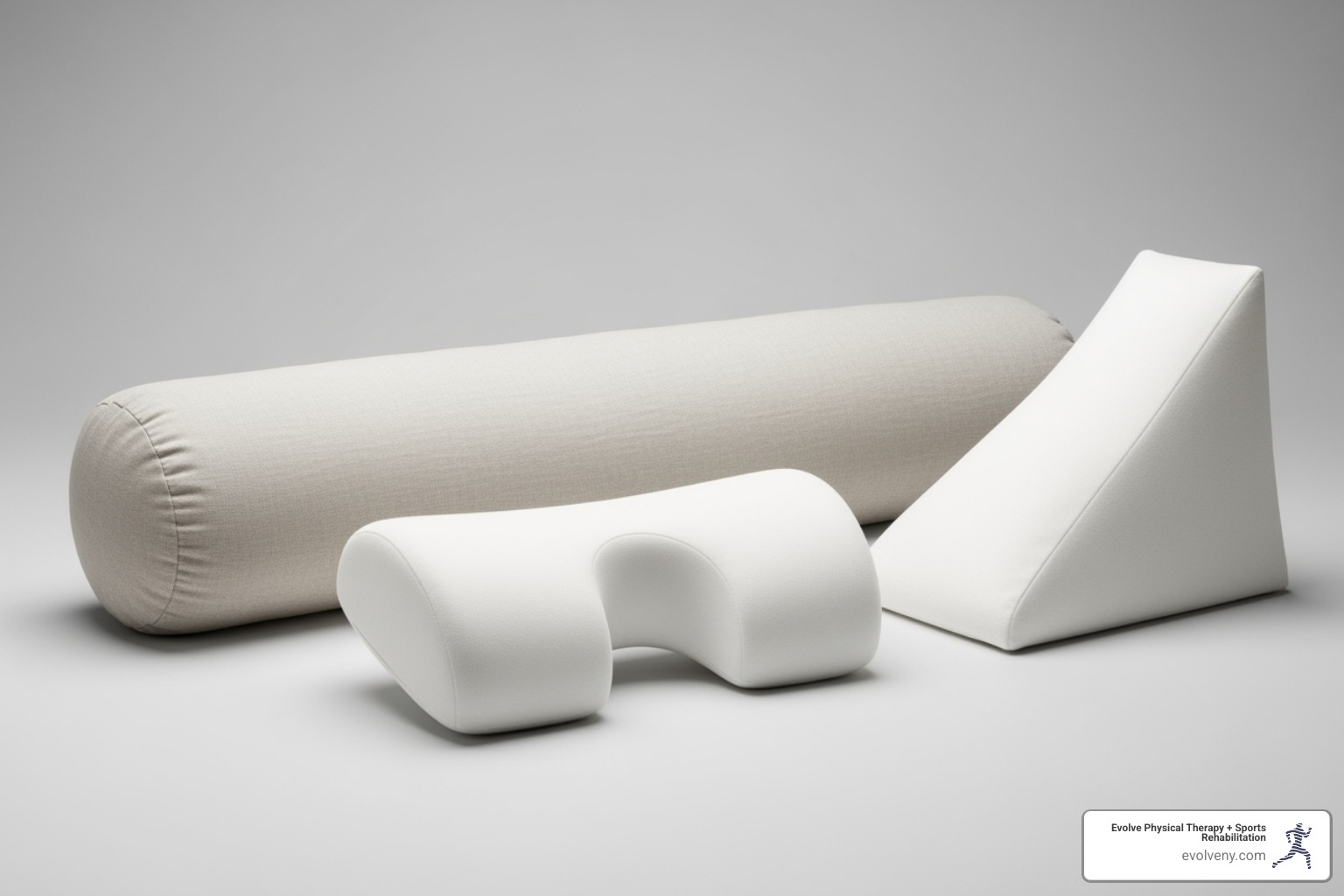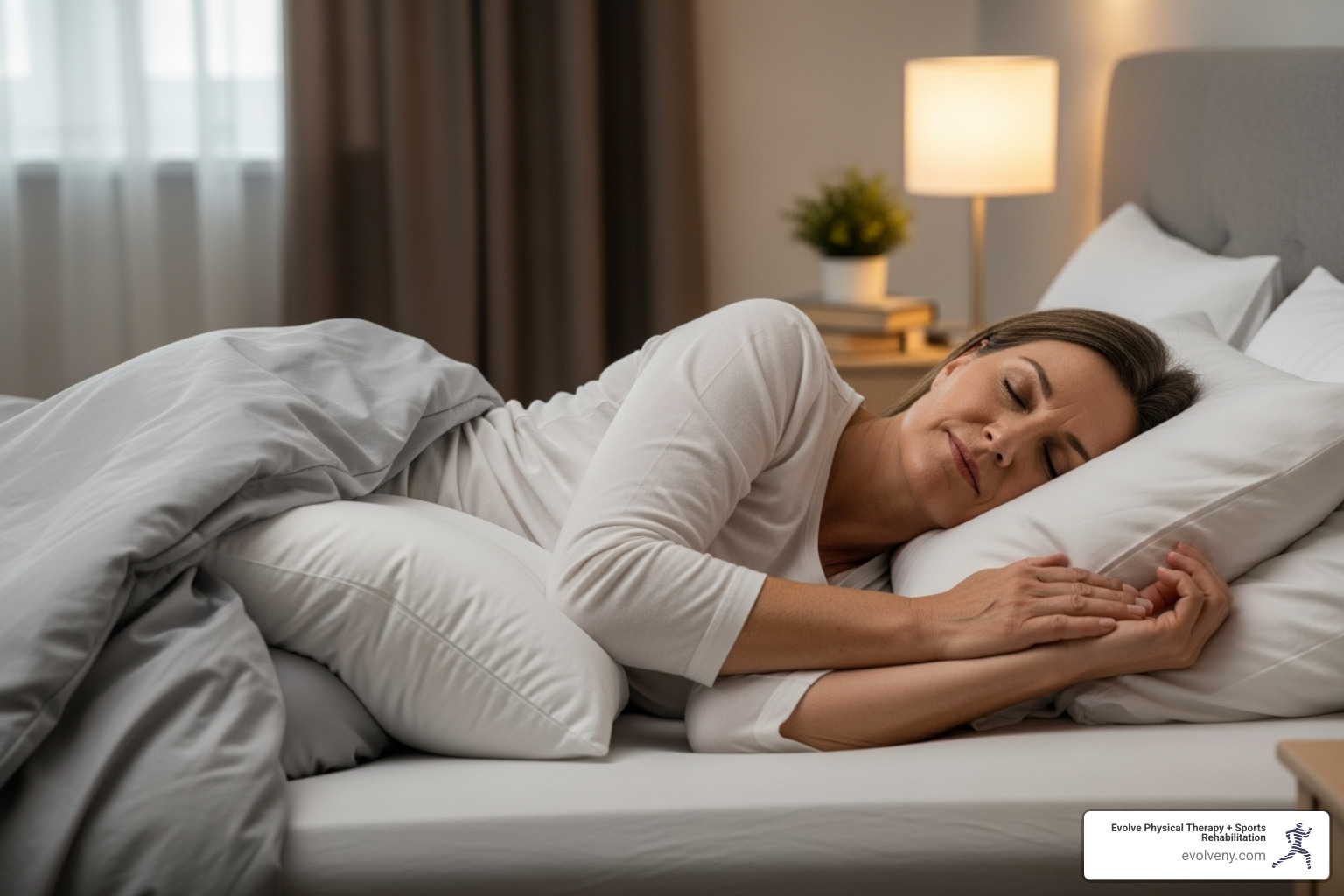Sleep Tight, Sleep Right: Ergonomic Sleeping Posture Tips
Why Ergonomics Sleeping Posture Matters for Your Body

Ergonomics sleeping posture is the practice of positioning your body during sleep to maintain natural spinal alignment and minimize stress on your joints and muscles. Since we spend about one-third of our lives sleeping, how we position ourselves directly impacts how we feel when we wake up.
Quick Answer: Key Principles of Ergonomic Sleeping Posture
- Side sleeping: Use a pillow between your knees and one that fills the gap between your ear and mattress.
- Back sleeping: Place a pillow under your knees and use a neck pillow that supports your natural curve.
- Stomach sleeping: Use a thin pillow (or none) and place one under your hips.
- Mattress: Choose medium-firm support to keep your spine aligned.
- Goal: Maintain the natural S-curve of your spine in any position.
Poor sleep posture isn't just about comfort; it's about the strain your body accumulates. When you sleep in positions that twist your spine or compress your joints, you're setting yourself up for morning stiffness, chronic pain, and poor sleep quality. With research showing that 84% of people report back pain at some point, sleep posture is a key factor in both causing and relieving it.
The good news is that small adjustments can lead to dramatic improvements. Whether you have a stiff neck, lower back pain, or just don't feel rested, understanding sleep ergonomics can help you break the cycle of pain and poor sleep.
I'm Lou Ezrick, a physical therapist at Evolve Physical Therapy in Brooklyn. With nearly two decades of experience, I've seen how improving sleep posture is often the missing piece for recovering from neck and back pain. Let's explore how you can transform your sleep and wake up feeling refreshed.

Your Sleep Foundation: Choosing the Right Mattress and Pillows
Your mattress is the foundation for your ergonomics sleeping posture. It should support your body's natural curves and distribute pressure evenly. While personal comfort is key, comfort without support leads to morning stiffness. A mattress that's too soft lets your spine sag, while one that's too firm creates pressure points. Research shows that medium-firm mattresses may effectively decrease pain among individuals complaining of back pain and improve sleep quality.
To test your mattress, lie on your back and slide a hand under your lower back. If it slides through with slight resistance, the firmness is likely good. A large gap means it's too firm; difficulty sliding your hand through means it's too soft. Most mattresses have a lifespan of 8-10 years. Visible sagging, feeling bumps, or rolling toward the middle are signs it's time for a replacement. If you consistently wake up with aches that fade after moving around, your mattress may be the culprit.
Focus on how a mattress supports your body rather than on marketing features like coil counts. For more details, a 2021 review on mattress choice for back pain offers further insight.
The Role of Pillows in Proper Sleep Posture

Your pillow's job is to fill the gap between your head and the mattress, keeping your head and neck aligned with your spine. The right pillow depends on your sleeping position, neck curve, and mattress firmness. A softer mattress may require a thinner pillow, while a firmer one may need a thicker pillow.
Your goal is a neutral, aligned position. If your pillow is too high, it pushes your head forward; too low, and it tilts back. If your current pillow isn't right, try adjusting its filling or adding folded towels to change its height. A rolled towel under your neck can also provide temporary support. A plush mattress pad can cause your body to sink, potentially requiring a thinner pillow.
Pillow Setups for Each Sleeping Position
Proper pillow placement can transform your ergonomics sleeping posture. Here’s how to optimize your setup:
For back sleepers, use a medium-loft pillow that supports your neck's natural curve without pushing your head forward. Place a small pillow or rolled towel under your knees to relieve lower back pressure.
For side sleepers, use a thicker pillow to fill the gap between your ear and the bed, keeping your head aligned with your spine. A firm pillow between your knees is essential to align your hips and reduce stress on your lower back.
For stomach sleepers, use a very thin pillow or no pillow at all for your head to minimize neck strain. Place a thin pillow under your hips to prevent your lower back from arching.
Body pillows are excellent for side sleepers. Hugging one can support your upper arm and prevent you from leaning forward, while placing it between your knees aligns your hips. This is especially helpful during pregnancy or for those with hip or knee pain.
Mastering the Positions: An Ergonomic Guide to Sleeping
The goal of ergonomics sleeping posture is to maintain neutral spinal alignment, keeping the natural curves of your spine intact just as they are when you stand tall. When your spine is aligned during sleep, pressure on your joints and ligaments decreases, and your muscles can fully relax and recover. Poor posture forces these structures to work overtime, leading to morning stiffness.
Side Sleeping: The Most Common Position
Over 60% of adults are side sleepers, a position we often recommend for back pain, snoring, and sleep apnea.

The key to proper side sleeping is placing a firm pillow between your knees. This prevents your top leg from pulling your pelvis out of alignment and twisting your lower back. Your head pillow should be thick enough to fill the gap between your ear and the mattress, keeping your head level with your spine. Rest both arms in front of you rather than under your head to avoid shoulder and nerve compression.
Side sleeping keeps your airways open, making it a form of positional therapy for snoring and sleep apnea. If you have acid reflux, research shows that sleeping on your left side can provide relief by using gravity to keep stomach acid down. For pregnant individuals, left-side sleeping improves blood flow to the heart, uterus, and baby.
Back Sleeping: The Gold Standard for Alignment
Back sleeping is often considered the gold standard for spinal health because it allows your body to rest in a neutral position, with weight distributed evenly.

The key is to place a small pillow or rolled towel under your knees. This supports your lower back's natural curve and reduces stress on your lumbar spine. For your neck, choose a low-loft pillow that cradles its natural curve without pushing your head too far forward. This position is often best for reducing neck pain because it allows neck muscles to rest.
However, back sleeping can worsen snoring and sleep apnea, as gravity can cause your tongue and soft tissues to block your airway.
Stomach Sleeping: How to Modify for Better Comfort
Stomach sleeping is the least recommended position because it puts significant strain on your neck and spine. To breathe, you must twist your head to one side for hours, which can lead to chronic pain. This position also provides the least back support and can cause your midsection to sink into the mattress, creating an unhealthy arch in your lower back.
If you cannot break the habit, these modifications can minimize the damage. Use the thinnest possible pillow for your head, or no pillow at all, to keep your neck in a more neutral position. Second, place a thin pillow under your pelvis or lower abdomen to counteract the arch in your lower back.
Stomach sleepers generally need a firmer mattress to prevent their midsection from sinking too deeply. At Evolve Physical Therapy, we encourage patients to transition away from this position for long-term neck and back health.
Sleep Solutions: How Ergonomics Sleeping Posture Affects Health
How you position your body for eight hours at night is just as important as your posture during the day. Sleeping in a twisted or strained position prevents your body from properly resting and healing, leading to morning aches and pains. Simple adjustments to your ergonomics sleeping posture can dramatically reduce these issues and improve your sleep quality.
Ergonomics Sleeping Posture for Back and Neck Pain
Back and neck pain are often linked to sleep habits. For lower back pain, side sleeping with a pillow between your knees is ideal to keep your hips and spine aligned. If you prefer sleeping on your back, a pillow under your knees is essential to take pressure off your lumbar spine.
Neck pain often responds well to back sleeping, which allows neck muscles to relax. In any position, the key is using a pillow that supports the natural curve of your neck, keeping your head in a neutral line with your spine. For a deeper dive, see our post on the best sleeping positions to combat back, neck, foot and elbow pain or this scoping review on sleep posture and spinal symptoms.
Breathing, Snoring, and Sleep Apnea
Your sleep position significantly impacts your breathing. Back sleeping is the worst position for snoring or sleep apnea because gravity can cause your tongue and soft tissues to fall backward and block your airway.
Side sleeping acts as natural positional therapy by keeping your airways open. For many people with positional obstructive sleep apnea, simply changing to a side position can significantly improve symptoms. Elevating the head of your bed by about six inches with blocks or a wedge pillow also uses gravity to your advantage, making it harder for airways to collapse.
Special Considerations: Pregnancy, Hip Pain, and Heartburn
Certain conditions require specific attention to ergonomics sleeping posture.
Pregnancy: Sleeping on your left side with knees bent is recommended to improve blood flow to the heart, uterus, and baby. A body pillow can support your belly and fit between your knees to maintain alignment.
Heartburn and GERD: Left-side sleeping can prevent stomach acid from flowing back into the esophagus. Combining this with elevating the head of the bed can further reduce nighttime reflux.
Hip and Knee Pain: For side sleepers, a pillow between the knees is non-negotiable to keep hips stacked and reduce stress. Back sleepers should place a pillow under their knees to keep joints slightly flexed and comfortable.
Frequently Asked Questions about Sleep Posture
What is the healthiest sleeping position?
While side sleeping is often considered the healthiest for most people because it supports spinal alignment and can help with snoring and acid reflux, there is no single "perfect" position. The best position is ultimately the one that allows you to sleep soundly and wake up feeling refreshed and pain-free. At Evolve Physical Therapy, our goal is to help you optimize your preferred position for your unique body and health needs.
How do I know if my mattress or pillow is wrong for me?
Your body will give you clear signals. Waking up consistently with stiffness, neck pain, or back pain that disappears after 15-30 minutes of moving around is a major red flag. For your mattress, look for visible sagging or indentations. For your pillow, the main sign it's wrong is if your head is tilted significantly up or down, rather than being in a neutral, straight line with your spine. If you're constantly bunching it up or adjusting it, it's not providing the right support.
How can I train myself to sleep in a new position?
Changing a long-term sleep habit takes patience, but it's possible. The key is to use pillows strategically to support your body and prevent you from rolling back into your old position. To become a side sleeper, try hugging a body pillow and placing another pillow behind your back to act as a "bumper." To become a back sleeper, place pillows on either side of you to create a supportive "nest." Always place a pillow under your knees for comfort, which makes the position more sustainable.
It may take a few weeks for your body to adapt. You will likely wake up in your old position at first; just readjust and be persistent. The long-term benefits for your ergonomics sleeping posture and pain levels are worth the adjustment period.
Conclusion: Waking Up Refreshed and Pain-Free
We spend roughly a third of our lives in bed, a crucial time for the body to repair itself, recover, and decompress. How you position yourself during this recovery time has a measurable impact on how you feel when you wake up.
Understanding ergonomics sleeping posture is about working with your body's natural alignment to minimize stress and maximize healing. Your bed is your nighttime workspace for recovery. Small, consistent adjustments—like adding a pillow between your knees or choosing a medium-firm mattress—can lead to big improvements in how you feel each morning. Give your body a few weeks to adapt to any new supports or positions.
Posture is a 24/7 activity. Eight hours of misalignment every night can undo the good work you do during the day. If you've tried optimizing your sleep setup and still wake up with pain, professional guidance can make all the difference. At Evolve Physical Therapy in Brooklyn, we look at the whole picture to create a personalized plan that works for your life. Our hands-on approach helps you understand your unique needs so you can function at your best.
Whether you're dealing with chronic pain or just want to wake up feeling better, we're here to help. Sleep tight and sleep right—your body will thank you for it.
Learn more about how our ergonomic physical therapy services in Brooklyn can help you achieve better sleep and a pain-free life.

